Management Communication: Leadership and Virtual Team Memo (MNG81001)
VerifiedAdded on 2023/06/08
|5
|1033
|279
Report
AI Summary
This memo addresses the crucial aspects of leadership and management within virtual teams, emphasizing the significance of effective communication for organizational success. It highlights the need for managers to be proactive in guiding their teams, establishing clear responsiveness protocols, and empowering team members through training and collaboration. The memo underscores the importance of focusing on results, providing incentives, and maintaining a cohesive culture to motivate geographically dispersed team members. It also acknowledges the challenges posed by cultural differences, varying time zones, and technological barriers. The author concludes by stressing the need for strategic approaches to overcome these challenges, ultimately enhancing the efficiency and performance of virtual teams. The memo is supported by references that further validate the claims.
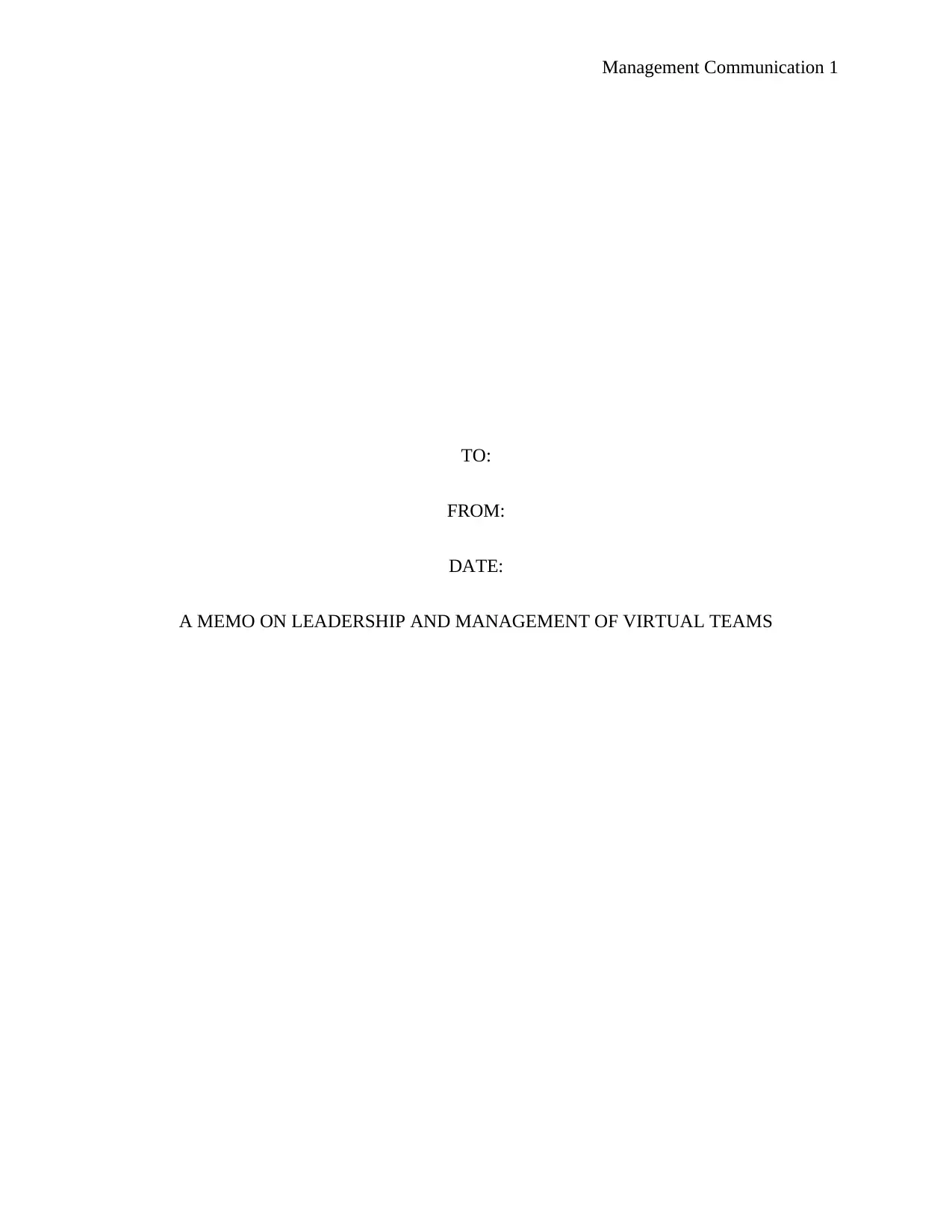
Management Communication 1
TO:
FROM:
DATE:
A MEMO ON LEADERSHIP AND MANAGEMENT OF VIRTUAL TEAMS
TO:
FROM:
DATE:
A MEMO ON LEADERSHIP AND MANAGEMENT OF VIRTUAL TEAMS
Paraphrase This Document
Need a fresh take? Get an instant paraphrase of this document with our AI Paraphraser
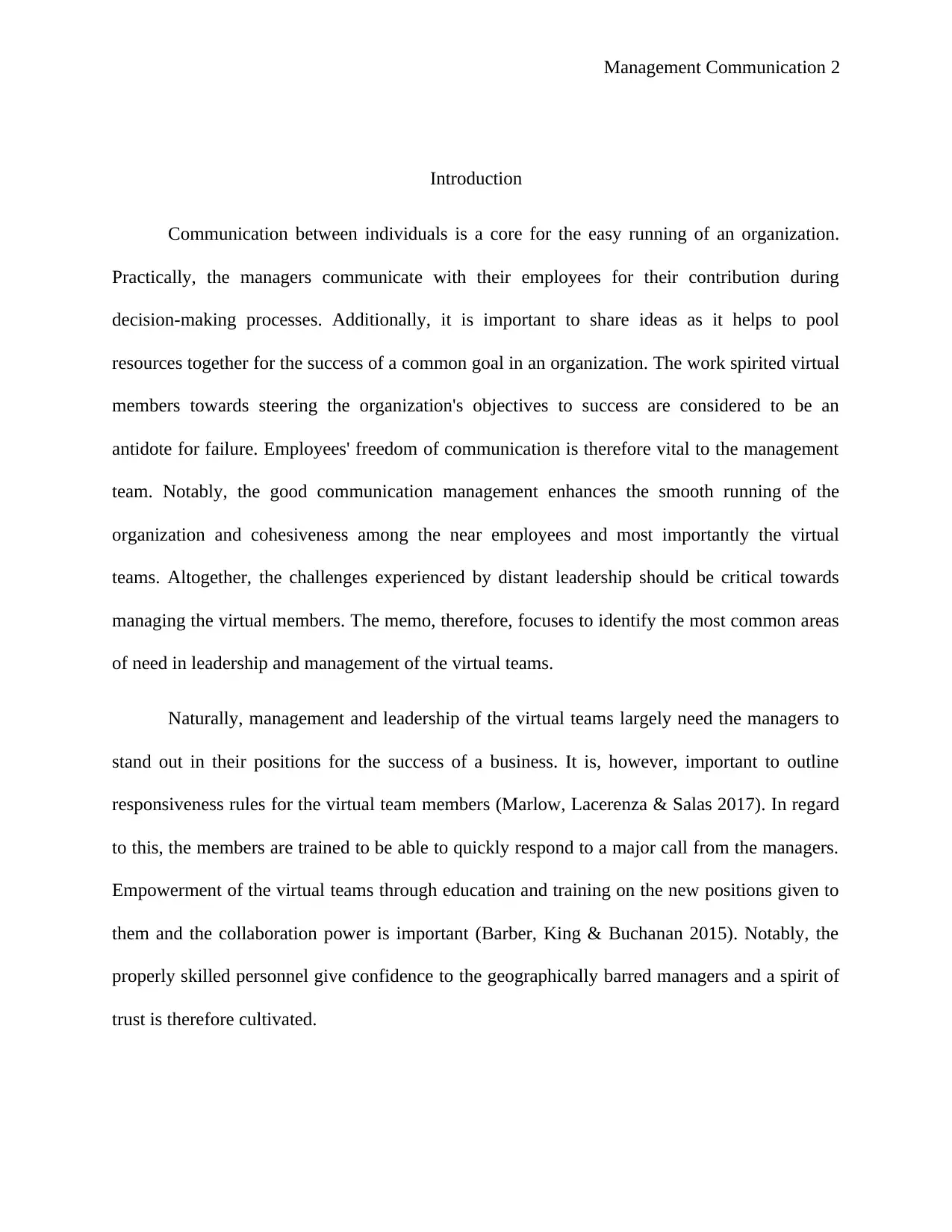
Management Communication 2
Introduction
Communication between individuals is a core for the easy running of an organization.
Practically, the managers communicate with their employees for their contribution during
decision-making processes. Additionally, it is important to share ideas as it helps to pool
resources together for the success of a common goal in an organization. The work spirited virtual
members towards steering the organization's objectives to success are considered to be an
antidote for failure. Employees' freedom of communication is therefore vital to the management
team. Notably, the good communication management enhances the smooth running of the
organization and cohesiveness among the near employees and most importantly the virtual
teams. Altogether, the challenges experienced by distant leadership should be critical towards
managing the virtual members. The memo, therefore, focuses to identify the most common areas
of need in leadership and management of the virtual teams.
Naturally, management and leadership of the virtual teams largely need the managers to
stand out in their positions for the success of a business. It is, however, important to outline
responsiveness rules for the virtual team members (Marlow, Lacerenza & Salas 2017). In regard
to this, the members are trained to be able to quickly respond to a major call from the managers.
Empowerment of the virtual teams through education and training on the new positions given to
them and the collaboration power is important (Barber, King & Buchanan 2015). Notably, the
properly skilled personnel give confidence to the geographically barred managers and a spirit of
trust is therefore cultivated.
Introduction
Communication between individuals is a core for the easy running of an organization.
Practically, the managers communicate with their employees for their contribution during
decision-making processes. Additionally, it is important to share ideas as it helps to pool
resources together for the success of a common goal in an organization. The work spirited virtual
members towards steering the organization's objectives to success are considered to be an
antidote for failure. Employees' freedom of communication is therefore vital to the management
team. Notably, the good communication management enhances the smooth running of the
organization and cohesiveness among the near employees and most importantly the virtual
teams. Altogether, the challenges experienced by distant leadership should be critical towards
managing the virtual members. The memo, therefore, focuses to identify the most common areas
of need in leadership and management of the virtual teams.
Naturally, management and leadership of the virtual teams largely need the managers to
stand out in their positions for the success of a business. It is, however, important to outline
responsiveness rules for the virtual team members (Marlow, Lacerenza & Salas 2017). In regard
to this, the members are trained to be able to quickly respond to a major call from the managers.
Empowerment of the virtual teams through education and training on the new positions given to
them and the collaboration power is important (Barber, King & Buchanan 2015). Notably, the
properly skilled personnel give confidence to the geographically barred managers and a spirit of
trust is therefore cultivated.
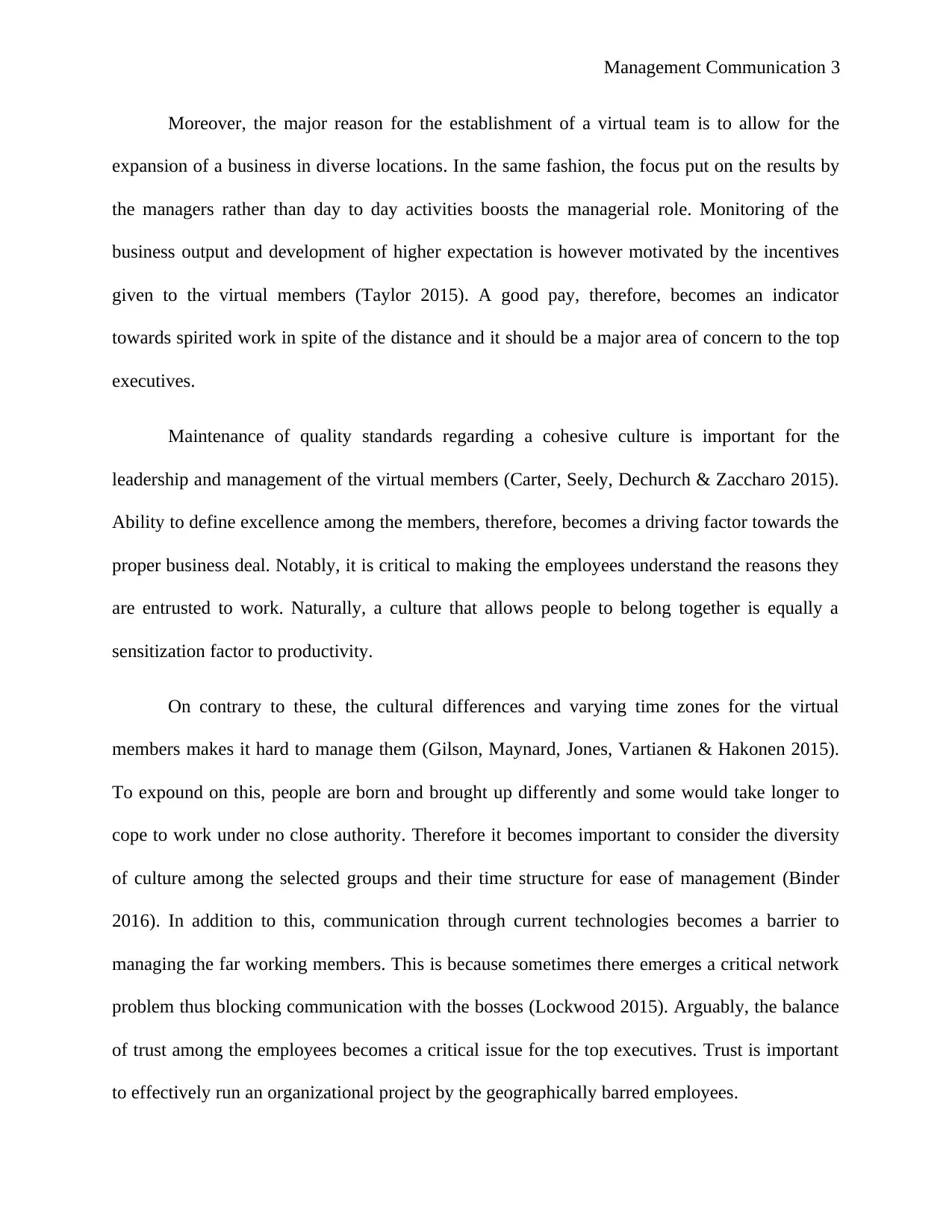
Management Communication 3
Moreover, the major reason for the establishment of a virtual team is to allow for the
expansion of a business in diverse locations. In the same fashion, the focus put on the results by
the managers rather than day to day activities boosts the managerial role. Monitoring of the
business output and development of higher expectation is however motivated by the incentives
given to the virtual members (Taylor 2015). A good pay, therefore, becomes an indicator
towards spirited work in spite of the distance and it should be a major area of concern to the top
executives.
Maintenance of quality standards regarding a cohesive culture is important for the
leadership and management of the virtual members (Carter, Seely, Dechurch & Zaccharo 2015).
Ability to define excellence among the members, therefore, becomes a driving factor towards the
proper business deal. Notably, it is critical to making the employees understand the reasons they
are entrusted to work. Naturally, a culture that allows people to belong together is equally a
sensitization factor to productivity.
On contrary to these, the cultural differences and varying time zones for the virtual
members makes it hard to manage them (Gilson, Maynard, Jones, Vartianen & Hakonen 2015).
To expound on this, people are born and brought up differently and some would take longer to
cope to work under no close authority. Therefore it becomes important to consider the diversity
of culture among the selected groups and their time structure for ease of management (Binder
2016). In addition to this, communication through current technologies becomes a barrier to
managing the far working members. This is because sometimes there emerges a critical network
problem thus blocking communication with the bosses (Lockwood 2015). Arguably, the balance
of trust among the employees becomes a critical issue for the top executives. Trust is important
to effectively run an organizational project by the geographically barred employees.
Moreover, the major reason for the establishment of a virtual team is to allow for the
expansion of a business in diverse locations. In the same fashion, the focus put on the results by
the managers rather than day to day activities boosts the managerial role. Monitoring of the
business output and development of higher expectation is however motivated by the incentives
given to the virtual members (Taylor 2015). A good pay, therefore, becomes an indicator
towards spirited work in spite of the distance and it should be a major area of concern to the top
executives.
Maintenance of quality standards regarding a cohesive culture is important for the
leadership and management of the virtual members (Carter, Seely, Dechurch & Zaccharo 2015).
Ability to define excellence among the members, therefore, becomes a driving factor towards the
proper business deal. Notably, it is critical to making the employees understand the reasons they
are entrusted to work. Naturally, a culture that allows people to belong together is equally a
sensitization factor to productivity.
On contrary to these, the cultural differences and varying time zones for the virtual
members makes it hard to manage them (Gilson, Maynard, Jones, Vartianen & Hakonen 2015).
To expound on this, people are born and brought up differently and some would take longer to
cope to work under no close authority. Therefore it becomes important to consider the diversity
of culture among the selected groups and their time structure for ease of management (Binder
2016). In addition to this, communication through current technologies becomes a barrier to
managing the far working members. This is because sometimes there emerges a critical network
problem thus blocking communication with the bosses (Lockwood 2015). Arguably, the balance
of trust among the employees becomes a critical issue for the top executives. Trust is important
to effectively run an organizational project by the geographically barred employees.
⊘ This is a preview!⊘
Do you want full access?
Subscribe today to unlock all pages.

Trusted by 1+ million students worldwide
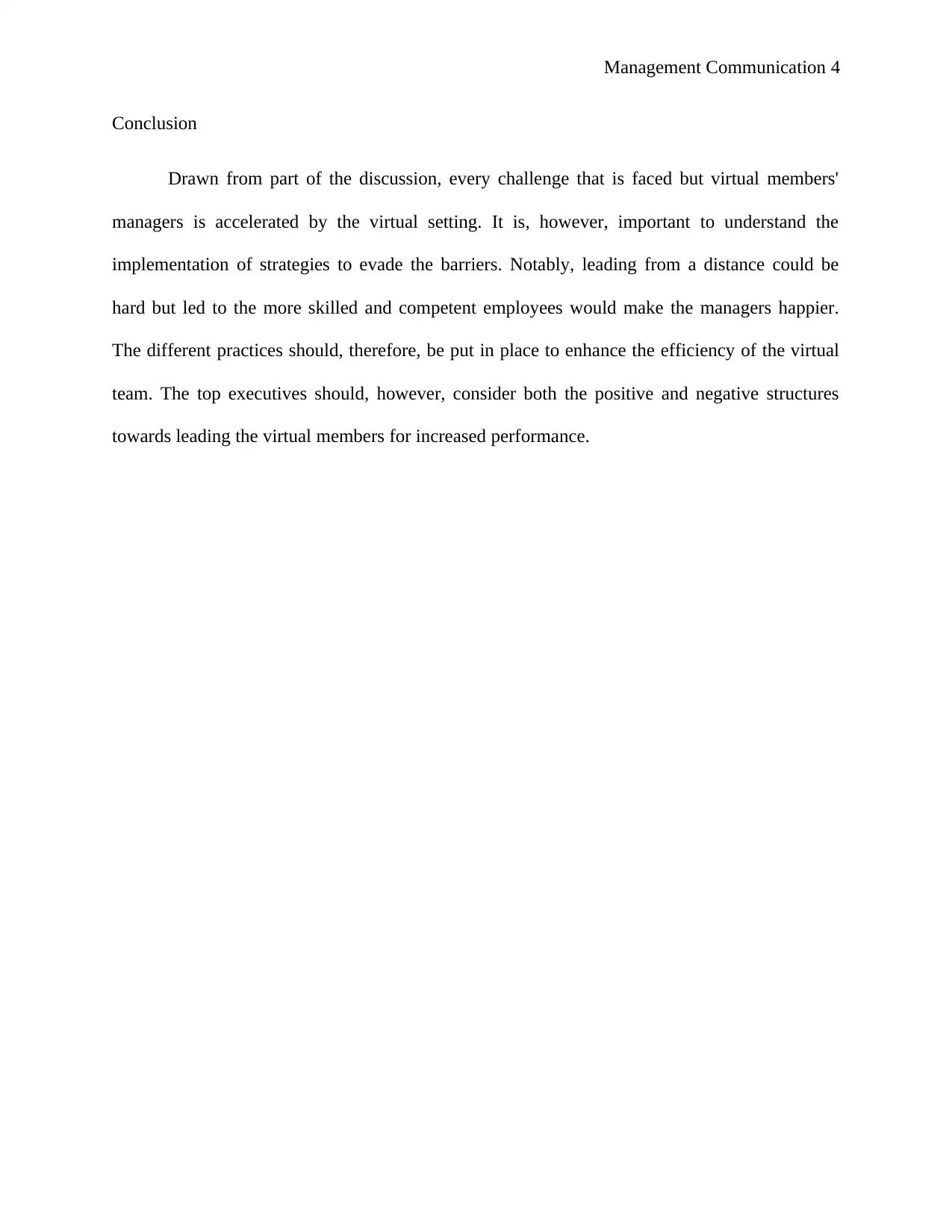
Management Communication 4
Conclusion
Drawn from part of the discussion, every challenge that is faced but virtual members'
managers is accelerated by the virtual setting. It is, however, important to understand the
implementation of strategies to evade the barriers. Notably, leading from a distance could be
hard but led to the more skilled and competent employees would make the managers happier.
The different practices should, therefore, be put in place to enhance the efficiency of the virtual
team. The top executives should, however, consider both the positive and negative structures
towards leading the virtual members for increased performance.
Conclusion
Drawn from part of the discussion, every challenge that is faced but virtual members'
managers is accelerated by the virtual setting. It is, however, important to understand the
implementation of strategies to evade the barriers. Notably, leading from a distance could be
hard but led to the more skilled and competent employees would make the managers happier.
The different practices should, therefore, be put in place to enhance the efficiency of the virtual
team. The top executives should, however, consider both the positive and negative structures
towards leading the virtual members for increased performance.
Paraphrase This Document
Need a fresh take? Get an instant paraphrase of this document with our AI Paraphraser
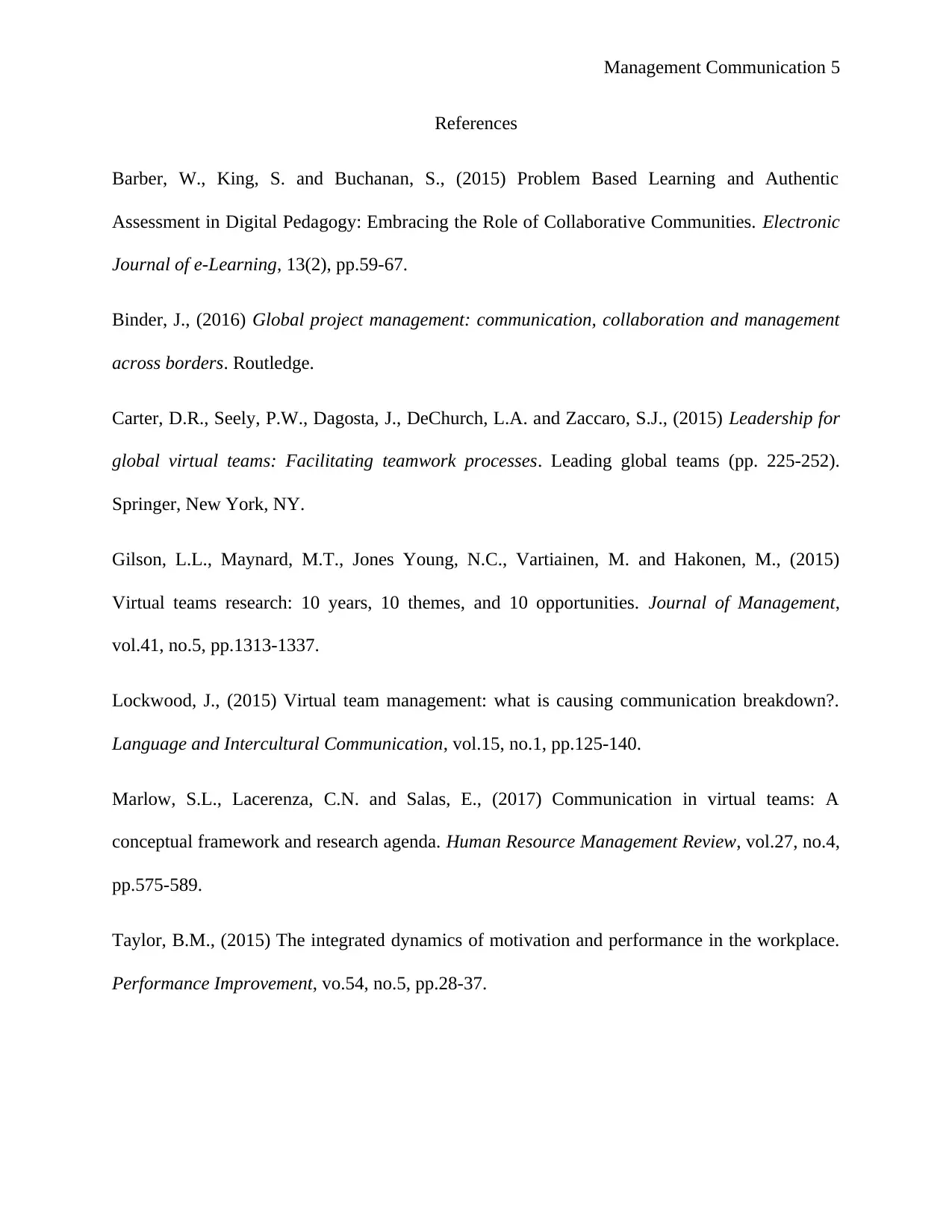
Management Communication 5
References
Barber, W., King, S. and Buchanan, S., (2015) Problem Based Learning and Authentic
Assessment in Digital Pedagogy: Embracing the Role of Collaborative Communities. Electronic
Journal of e-Learning, 13(2), pp.59-67.
Binder, J., (2016) Global project management: communication, collaboration and management
across borders. Routledge.
Carter, D.R., Seely, P.W., Dagosta, J., DeChurch, L.A. and Zaccaro, S.J., (2015) Leadership for
global virtual teams: Facilitating teamwork processes. Leading global teams (pp. 225-252).
Springer, New York, NY.
Gilson, L.L., Maynard, M.T., Jones Young, N.C., Vartiainen, M. and Hakonen, M., (2015)
Virtual teams research: 10 years, 10 themes, and 10 opportunities. Journal of Management,
vol.41, no.5, pp.1313-1337.
Lockwood, J., (2015) Virtual team management: what is causing communication breakdown?.
Language and Intercultural Communication, vol.15, no.1, pp.125-140.
Marlow, S.L., Lacerenza, C.N. and Salas, E., (2017) Communication in virtual teams: A
conceptual framework and research agenda. Human Resource Management Review, vol.27, no.4,
pp.575-589.
Taylor, B.M., (2015) The integrated dynamics of motivation and performance in the workplace.
Performance Improvement, vo.54, no.5, pp.28-37.
References
Barber, W., King, S. and Buchanan, S., (2015) Problem Based Learning and Authentic
Assessment in Digital Pedagogy: Embracing the Role of Collaborative Communities. Electronic
Journal of e-Learning, 13(2), pp.59-67.
Binder, J., (2016) Global project management: communication, collaboration and management
across borders. Routledge.
Carter, D.R., Seely, P.W., Dagosta, J., DeChurch, L.A. and Zaccaro, S.J., (2015) Leadership for
global virtual teams: Facilitating teamwork processes. Leading global teams (pp. 225-252).
Springer, New York, NY.
Gilson, L.L., Maynard, M.T., Jones Young, N.C., Vartiainen, M. and Hakonen, M., (2015)
Virtual teams research: 10 years, 10 themes, and 10 opportunities. Journal of Management,
vol.41, no.5, pp.1313-1337.
Lockwood, J., (2015) Virtual team management: what is causing communication breakdown?.
Language and Intercultural Communication, vol.15, no.1, pp.125-140.
Marlow, S.L., Lacerenza, C.N. and Salas, E., (2017) Communication in virtual teams: A
conceptual framework and research agenda. Human Resource Management Review, vol.27, no.4,
pp.575-589.
Taylor, B.M., (2015) The integrated dynamics of motivation and performance in the workplace.
Performance Improvement, vo.54, no.5, pp.28-37.
1 out of 5
Related Documents
Your All-in-One AI-Powered Toolkit for Academic Success.
+13062052269
info@desklib.com
Available 24*7 on WhatsApp / Email
![[object Object]](/_next/static/media/star-bottom.7253800d.svg)
Unlock your academic potential
Copyright © 2020–2025 A2Z Services. All Rights Reserved. Developed and managed by ZUCOL.




